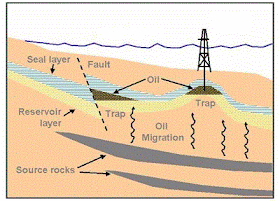 |
| Reservoir, trap, and seal |
McGee opens with the astoundingly uneducated claim that,
"Reservoir rock commonly refers to the porous rock that contains oil or the non-porous rock that holds water."We immediately wondered how, if a rock is "non-porous," it holds water. More to the point, the water-bearing portions of a porous reservoir rock are variously referred to by people who know what they're talking about (as opposed to McGee) as the water leg or, more scientifically, the aquifer. That, unfortunately, is only the beginning. Check out this claim:
"In the oil-based usage, a reservoir rock is formed when a non-porous layer shears a porous rock that contains oil."The geologist thinks that maybe, just maybe, McGee's confused impermeable rocks with a fault seal, but who knows? WiseGEEK doesn't publish sources. Whatever the case, rock layers don't "shear" each other (except maybe dikes). McGee continues, submitting the passage that will be used in his (her?) nomination for Dumbass of the Year:
"Oil is found in porous sedimentary rocks such as limestone and sandstone. As these layers of rock move up and down, oil is squeezed out towards the surface. While any oil-baring rock is technically a reservoir rock, the term is generally used to describe systems where the oil is blocked from any additional upwards movement."That crap was almost enough to give our petroleum guy a stroke. Let's unpack the stupidity:
- Oil's found in almost every kind of rock. Limestone and sandstone are just two of the more common types.
- Layers of rock do not "move up and down" in any way that someone of McGee's sensibilities (Communications major? English Lit? Creative writing?") might understand. Perhaps McGee was describing folding, but who knows?²
- It isn't "oil-baring," it's oil-bearing; idiot.
- Geologists typically consider a porous rock that contains oil moving from its source to a trap to be a "migration pathway," not a reservoir.
"When a crack forms and the rock layers become mismatched, the oil can’t continue through the non-porous material. Even though it can get anywhere, the oil continues to move upwards and creates an area that is very oil -rich right under the crack."
| Suffice it to say that this article reads very much like a term paper written by a middle-schooler (and given an A by a teacher who's every bit as clueless as McGee's editor, Lauren Fritsky). The remainder of the article (another 225 words) is far-ranging, revealing that McGee is just as ignorant of hydrology as s/he is of petroleum geology. Whatever the case, M. McGee has given the internet a remarkable dollop of stupidification, dumbassery so remarkable that there is no way we can let it pass without special recognition: M, you're now our Dumbass of the Day – and we've placed your name on our list of people to check for more stupidity when we're running low on time. |
¹ McGee also published at eHow, but not under that name...
² Interestingly enough, petroleum is often flushed from source rocks by compaction during burial. Maybe that's the "up and down" McGee prattles about.
copyright © 2018-2021 scmrak
SI - OIL
No comments:
Post a Comment